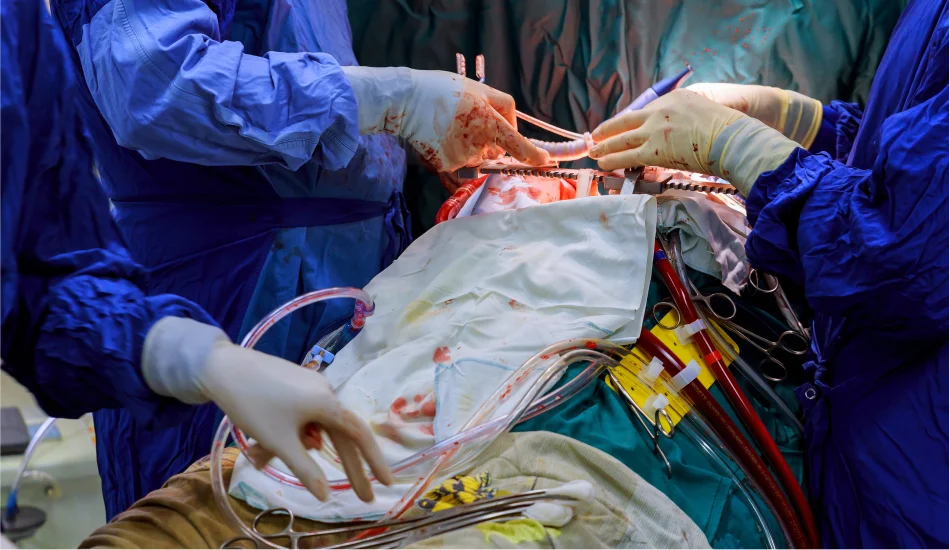
Coronary Artery Bypass Grafting (CABG) is a life-saving surgery that provides a fresh perspective for those with severe coronary arterial disease (CAD). CAD is a condition in which the coronary arteries, which are responsible for providing oxygen-rich blood the muscle of your heart, are narrowed or blocked as a result of the accumulation of plaque, which is a mixture of cholesterol, fat, as well as other components. It can cause painful symptoms such as discomfort in the chest (angina) and breathlessness and a higher chance of having heart attacks.
The purpose behind CABG
The main purpose for Coronary Artery Bypass Grafting can be used to increase the flow of blood to the heart through bypassing the blocked or narrowed segments of coronary arteries. This is accomplished through the use of an appropriate blood vessel that is healthy from another body part to establish a new path for blood to flow into in the cardiac muscle. Through restoring circulation, Coronary Artery Bypass Grafting can significantly reduce symptoms, improve the quality living, as well as decrease risks of heart problems.
Understanding the need for CABG
Coronary Artery Bypass Grafting is frequently suggested for patients with :
- Massive blockages in coronary arteries that are multiple when multiple arterial arteries become blocked, your heart’s capacity to draw enough blood is seriously compromised.
- A significant blockage of the coronary artery left The artery that supplies much of the muscle in your heart and its blockage could have grave effects.
- Intractable chest pain (angina): When chest pain is persistent despite medication as well as other therapies, Coronary Artery Bypass Grafting may be necessary.
- Treatments that have failed previously Patients who had other procedures, such as angioplasty, with no success may need Coronary Artery Bypass Grafting.
The Coronary Artery Bypass Graft Procedure
CABG can be done using various methods, depending on the condition of the patient and the surgeon’s skills. The principal kinds of CABG procedures include :
- The traditional CABG The most commonly used method, in which the surgeon makes an incision on the chest in order to access the heart. The patient is positioned on a machine called a heart-lung that takes control of the heart’s pumping actions throughout the process. The surgeon will then take the healthy blood vessel typically in the legs (saphenous vein) or arms (radial artery) as well as the chest (internal mammary vein) and transfers it onto the coronary artery, above and beneath the obstruction.
- Off-Pump CABG Also referred to in the context of “beating heart surgery,” the procedure is carried out when the heart is beating. The surgeon makes use of specific equipment to stabilize the region of the heart that is being treated, removing the need for a heart lung machine. This method can lower some risk associated with traditional Coronary Artery Bypass Grafting.
- Minimally Invasive CABG This procedure involves smaller incisions and instruments that are specialized that result in less trauma to the body and faster time to recover. It is a good option for some patients, based on the extent and location of the obstructions.
The preparation for CABG
The preparation for CABG surgery requires various steps to ensure the security of the patient and procedure’s success :
- Medical Assessment An in-depth evaluation, which includes blood tests, chest Xrays along with Electrocardiogram (ECG) to determine the overall health of the patient and fitness for surgery.
- Medical Review Certain medications could require adjustment or stopped prior to surgery in order to reduce the risk.
- Lifestyle Changes Stopping smoking, implementing a healthier diet and engaging regularly in exercise can help improve the outcome of surgical procedures.
- instructions for pre-surgery Patients will be given specific instructions on drinking, eating and taking medications at night prior to surgery.
Recovery Following CABG
The recovery from CABG surgery is different between individuals, but it generally follows a prescribed procedure :
- Hospitalization The typical hospital stay is in the hospital for between 5-7 days. The initial few days being spent in the ICU for monitoring closely.
- The treatment of pain is done through medications, and patients are encouraged to move to prevent problems such as blood clots.
- Gradual Increase in Activity Patients begin with a light walk then gradually increasing their amount over the course of several weeks.
- Follow-up appointments Regular visits to the cardiologist for monitoring the progress of your condition and adjust medications according to the need.
Risks and complications of CABG
As with any major surgery, CABG carries some risks and possible complications, such as :
- Infection Infection at the site of incision or inside the chest.
- Bleeding both before and after the operation.
- Heart Stroke or Attack Although rare the possibility of them occurring is either during or after the procedure.
- Arrhythmias Heartbeat irregularity that could require treatment.
- Graft Failure In time the new grafts may also be blocked.
Long-Term Care Following CABG
Lifestyle changes and long-term care are vital for your success with CABG procedure. Important elements include :
- Medical Adherence taking prescribed medication to avoid blood clots reduce cholesterol, and control blood pressure.
- Healthful Diet eating a diet high in vegetables, fruits whole grains, lean proteins, while staying clear of saturated fats and sugars.
- Regular exercise Regularly engaging in physical exercise to strengthen your heart, and boost overall fitness.
- Regular Check-ups Regular visits to a cardiologist to assess the health of your heart and modify treatments as needed.
The Function of Cardiac Rehabilitation
Cardiac rehabilitation is a controlled program that is designed to improve your cardiovascular health following surgery. It generally consists of:
- exercise training Exercise programs that are structured and designed to meet the needs of each person.
- Education Information about healthy lifestyles for heart health which includes exercise, diet, and managing stress.
- Support Support for emotional and psychological assistance for patients to adjust to life post-surgery.
Conclusion
Coronary Artery Bypass Grafting (CABG) is an essential procedure for patients suffering from serious coronary artery disease. Through understanding the procedure properly, being prepared, and making commitments to the long-term changes in lifestyle patients can have great results and live an active, healthier life. If you or someone close to you has been diagnosed with Coronary Artery Bypass Grafting, feel confident knowing that this procedure has been tried and tested. provides hope and healing for an improved future.



